My fascination with the flag paintings of American painter Jasper Johns - flag 1954
Author: Distil Ennui | Post Date: 15-09-2022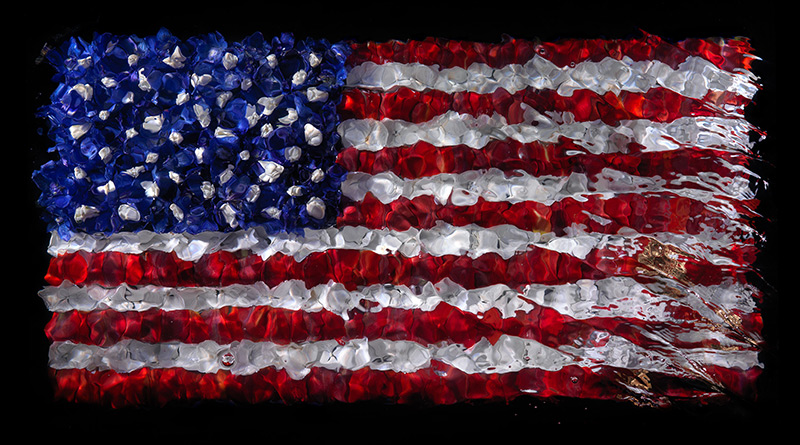
'Plate 0180' backlit 145 x 80 cms fuji crystal archive print, backlit in museum frame
From Joe Rosenthal’s iconic, 'Raising of the Flag on Iwo Jima' to Jasper Johns’ equally renowned 'Flag' of 1954, The Stars and Stripes of the United States have remained an emblem of deep significance to a great number of artists throughout history. Whether used to symbolise the country’s pride or to express its downfalls, the flag has retained an almost unparalleled gravity when captured by the hand of an artist.

Joe Rosenthal, ‘Flag Raising on Iwo Jima’ 1945
Flag is an encaustic painting by the American artist Jasper Johns. Created when Johns was 24 (1954–55), two years after he was discharged from the US Army, this painting was the first of many works that Johns has said were inspired by a dream of the U.S. flag in 1954. It is arguably the painting for which Johns is best known.
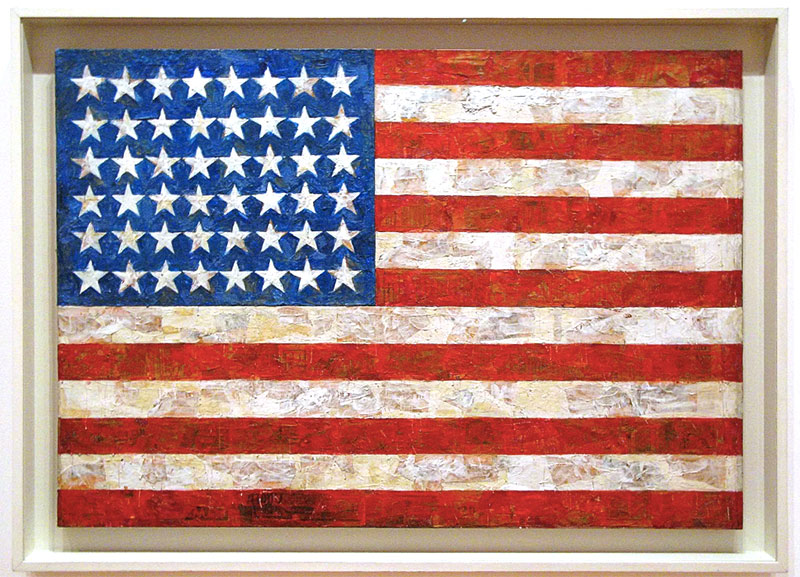
Jasper Johns, 'Flag' 1954, image courtesy MOMA.
Bringing my own unique conception of the flag so as to place it under a renewed and critical lens. By returning to the theme of Vanitas - contrasting images of the beautiful with the deathly - I am lamenting America’s vision of democracy, capturing the flag in an ‘undulating wave of gold etched turbulence’.
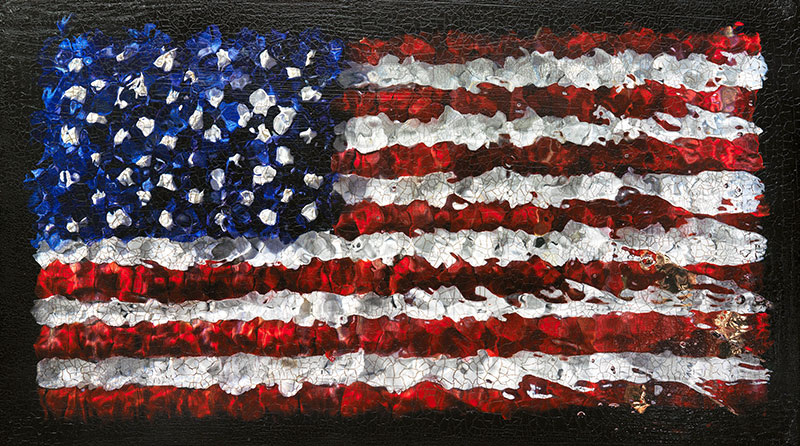
Vanitas painting 'Flag 0518' 59.4 x 33.3 cms. from 'Death of the dream of democracy' 2014-2017
Akin to the butterflies from the 'Swarm' series of 2008-2012 and 'Transparency of a dream 2013-2016' here I render the image of the flag in a manner that is simultaneously beautiful and tragic; beautiful but on the edge of disintegration. Like the delicate wings of the insect, here 2000 individually embroidered tulip and rose petals that form the flag’s tapestry are emphasised in their fragility by the weight of the water and the darkness they are set against. A philosophy that explores each piece in relation to painting with light through the alchemy of water, by distinctly combining photography, sculpture and painting in one singular, unique image.

'Plate 0813-10' from the series 'Transparency of a dream' 2013-2016, underwater butterfly photography series
Here, with water as an elemental medium at the core of my practice, ‘Death of the Dream of Democracy’ highlights the turbulence of America’s recent political landscape.
Water is a core element of my practice and globally it is in crisis with rising sea levels from global warming, overfishing, plastic pollution and freshwater pollution through deforestation and the clearly linked rising CO2 levels. The Paris Agreement is a genuine pathway towards de-carbonisation.
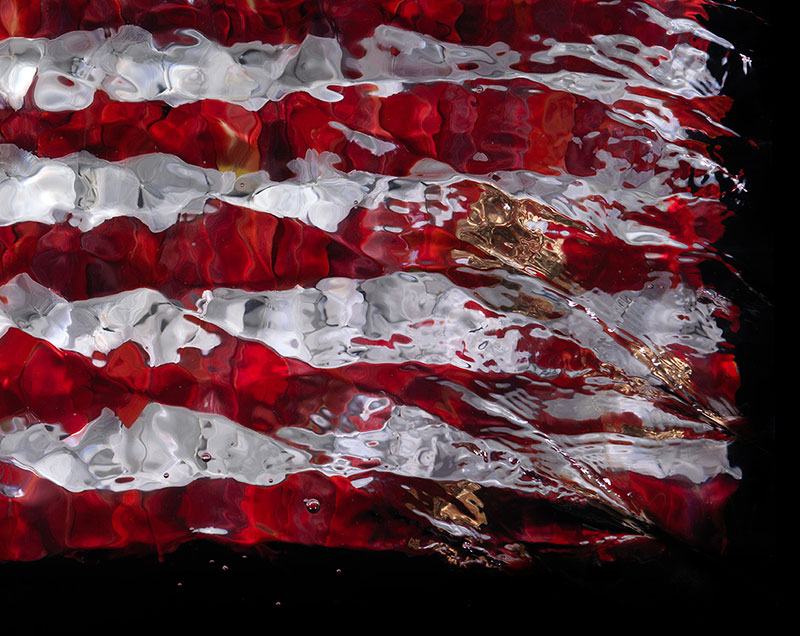
detail view of 'Plate 0180' backlit 145 x 80 cms fuji crystal archive print, backlit in museum frame
The fragility of the American flag stands as a metaphor for socio-political condition of the country which it represents. Perceiving America under its current presidencies to be in a state of instability. Like its constituent parts, its founding ideals of democracy, liberty, opportunity and equality are under threat from the unrest caused by its newly elected leaderships. With each disturbance to the water, the bold lines of the American flag become less defined, masterfully captured in an effervescent-swirl that marks a period of crucial importance within the history of the United States.
The addition of 24-carat gold leafs evokes the material excess and manifested by contemporary capitalism. It recalls a long and troubled history etched into the founding of the United States. From the genocidal Californian Gold Rush of 1849, to the hoarding of bullion during the Great Depression, gold signals pursuit that has led many men and women astray.

Gustav Klimt, ‘Portrait of Adele Bloch-Bauer I’ (1907). Oil, silver, and gold on canvas, 138 cm × 138 cm
Gold - the colour of the gods - follows in the footsteps of art history. Drawn from age of Tutankhamen to decorate the sarcophagi, gold represented the immense wealth and power of the Pharaoh. It was used to decorate the chryselephantine statues of ancient Greece. In the art of the Renaissance, it was viewed as the divine light, while gold leaf gleamed the pages of Medieval manuscripts. In the 20th Century, gold adorned the canvases of Gustav Klimt (fig. 2). Indeed, gold is evermore associated with wealth and status in society, the nature of value in culture. Here, signifying a malady of conspicuous consumption, gold’s influence spreads across the American flag; tarnishing it’s image that once was held with such prestige.
My inspiration for the series is an aesthetic reaction to the current political climate in America; a country whose very constitution appears under threat by neoliberal economics and unruly spectre of President Trump, who espouses, ‘He who has the gold makes the rules’. Indeed, my discerning application of gold professes his concern for a leader of the free nation that places such conviction in material goods, and a society in which positions of power are more and more frequently being awarded to the highest bidder.
Having weaved the tapestry of rose and tulip petals together to create flag works, 'Death of the dream of democracy' recalls the excessive heights of ‘Tulipmania’ of the Dutch Golden Age; whereby a wild speculative bubble and irrational behaviours demonstrated by economic markets show at a glance the decline and fall of the republic’s leading economic and financial power. The ritual invocation of the Dutch Vanitas constitutes the sole critical act of the artist’s view as allegory: ‘Beauty, riches, power, joy, art, and the fame of high position, Yes, all that is of the world, will pass like a flower’ (a reference to Psalm 103:15). In this sense, the tapestry of flowers that weave together the Stars and Stripes is simultaneously beautiful and tragic in existence.
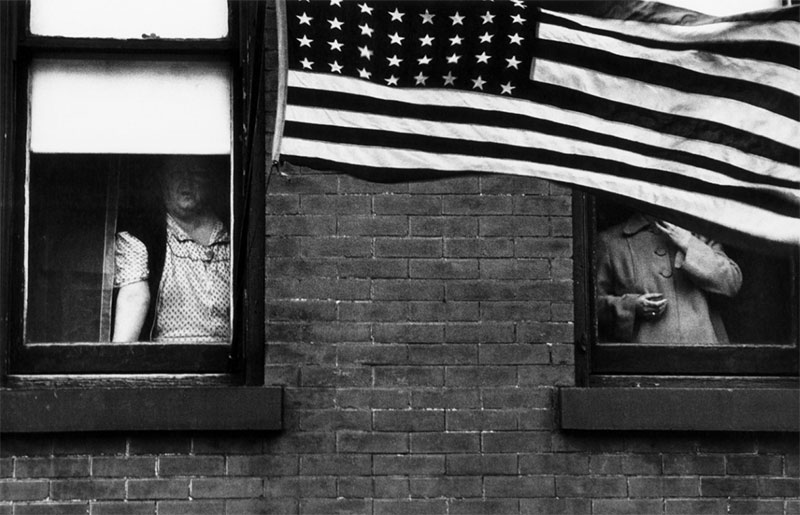
Robert Frank from his seminal 1958 publication, 'The Americans'
Just as the pioneering photojournalistic work of Robert Frank and his seminal 1958 publication, The Americans, juxtaposed icons of American ideals with the grinding reality of city living, This work captures the visceral tension between American glossy consumer culture and the country’s founding political and social values of liberty, opportunity and equality. Frank’s photographic study of American life retains its value today because it documented a period of great social and economic change within the country, ’ The Death of The Dream of Democracy ’ is of historical gravity in so far as it captures in a single iconic image - a moment of immense and significant change within the United States of America that will be remembered by generations.
Whereas Frank used the blur of city to capture its turbulence, James applies the subtler motions of the water to convey a sense of unrest.

9 x 9 grid of vanitas flag paintings, central flag inverted a maritime signal of distress.

installation view Death of the dream of democracy' 2017, Dellasposa Gallery, London.

installation view Death of the dream of democracy' 2017, Dellasposa Gallery, London.
NB.. texts adapted from the exhibition catalogue written by Jessica Phillamore, curator and founder Dellasposa Gallery, London. View the exhibition 'Death of a dream'.
I hope you found this journal entry informative, please stay connected.
Join the mailing list.. Register
Telegram Channel.. DistilEnnui
Instagram.. AJHamilton.Artist
Twitter.. DistilEnnui
Support on Patreon.. SustainableArt